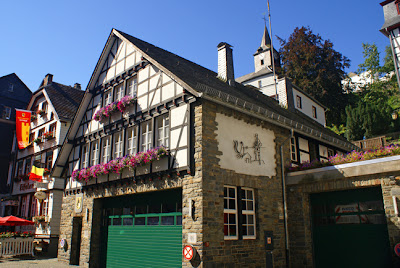
The Eifel region of Germany, that is! Just under 3 hours' drive from Wassenaar, we visited the part of the Eifel region that borders The Netherlands and Belgium.
Aachen is probably one of the most historic German towns you've never heard of. The town is dominated by the cathedral (left), part of which dates back to the reign of Charlemagne. While the exterior (with its mishmash of styles) and the interior (particularly the mosaic dome) are interesting, the treasury is the real can't miss. Several huge reliquaries, a sarcophagus dating from the second century, and numerous other invaluable relics are displayed here. Charlemagne built quite a treasure trove of goodies, and Aachen's importance as a place for the coronation for German kings evidently kept the riches rolling in for some time.


Above: Charlemagne (looking a little concerned); detail from the cathedral roof


Above: cathedral interior; mosaics in the dome


Above: decorative mosaics, Persephone sarcophagus



Above: Charlemagne's bust and reliquaries from the cathedral treasury
Of course, there are more sights than just the cathedral. There are more statues than you can count, and the streets are filled with shops selling the local delicacy printen (a sort of chewy gingerbread).
Above: local statuary (the one in the middle picture moves!) and a printen shop window

We happened upon a pretty busy day: stag/hen parties, a string trio, and a bike race! All that and we still found time to relax at a friendly wine bar (those are real grapes pictured above).

Above: a groom-to-be, string trio



Above: scenes from the bike race
The following day we visited two picturesque villages. We blogged about the second town, Valkenburg (NL), on our daily blog. Our first stop on Sunday was the picture-postcard town of Monschau (DE). Situated about a half hour's drive south of Aachen, it is nestled along the sleepy riverbank of the river Rur. Tourism seems to be the order of the day; not very crowded when we first arrived, by afternoon it was bustling with activity.
Above: Monschau contains lots of pretty half-timbered buildings, old churches, and interesting architectural details like downspouts shaped like lobsters.



Among the sights (pictured above) were a sculpture garden, a brass band, and perhaps the prettiest firehouse we've ever seen. After a nice riverside meal, we set off for home relaxed and ready for our trip back to the US to visit family & friends.
We'll do a mini post on Chicago in two weeks as our next installment.









































